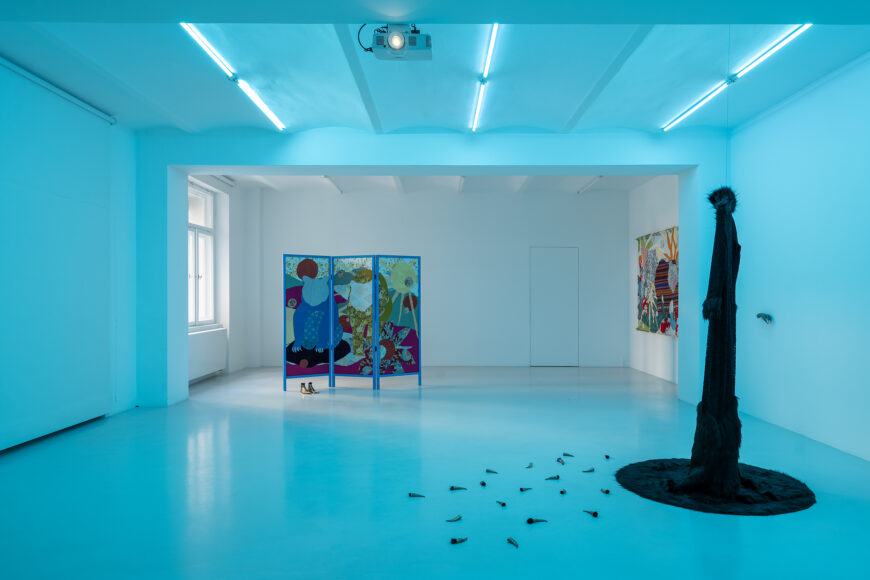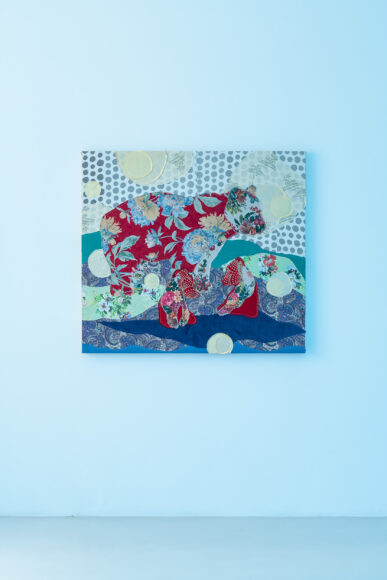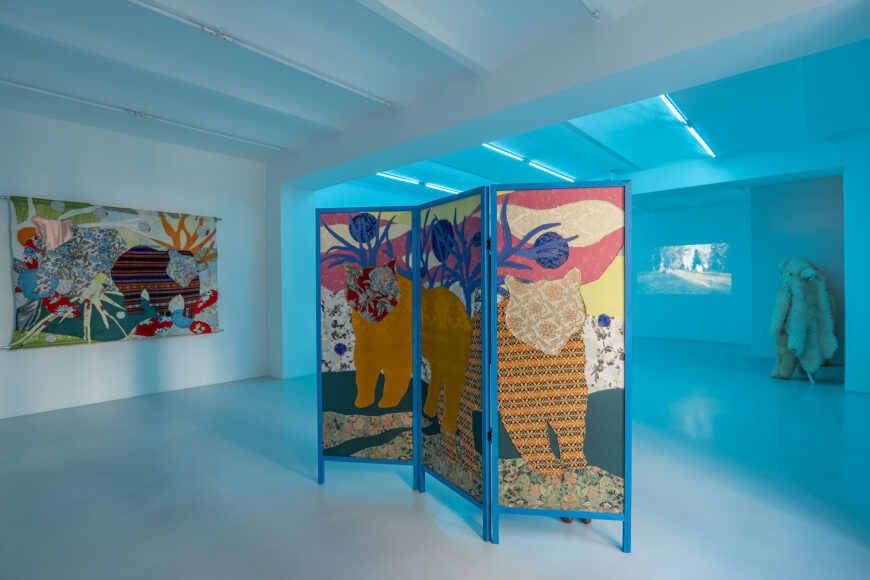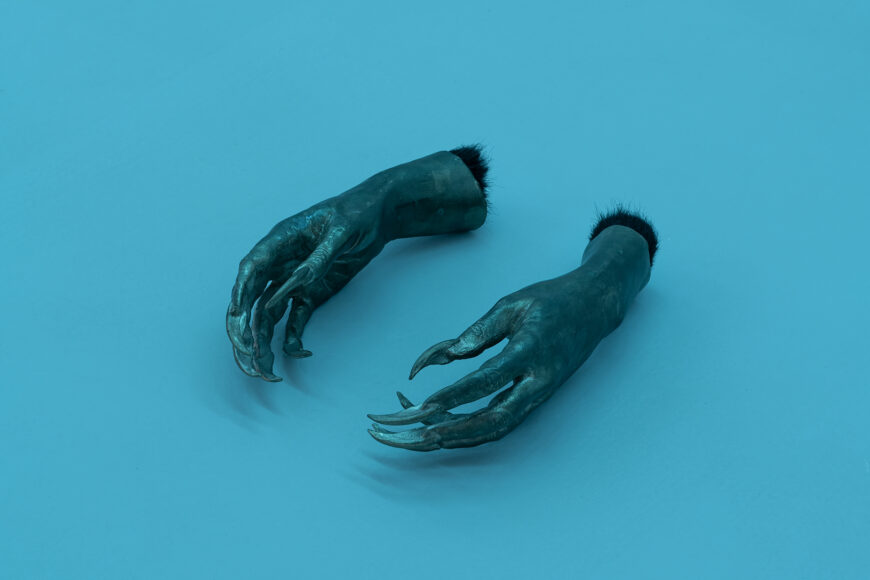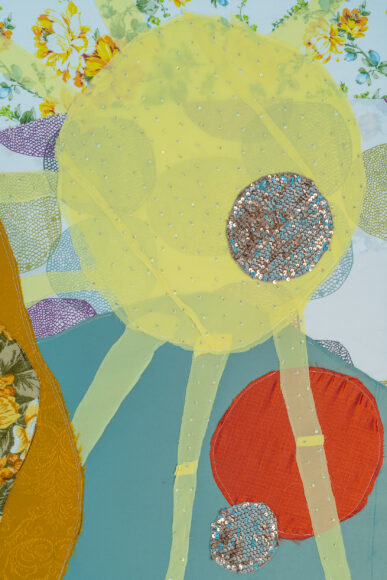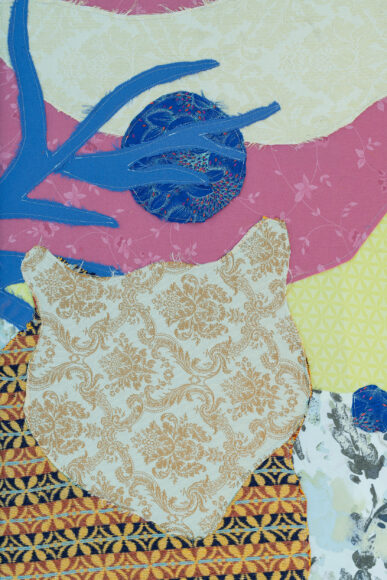Katarzyna Depta-Garapich, Małgorzata Mirga-TasYOU ATE THREE HUNDRED DEVILS curator: Marta Lisok
30.06-22.09.23
Due to the great power attributed to it, the name of this species was shrouded in taboo. It was replaced by terms imitating the ferocious sound it made or words referring to its special status in beliefs. It was called “The Ancestor”, “The Eldest of the Forest”, and “The One Who Hears Everything.” It was referred to as “The Dark One” or using the sinister pronoun “He”.
The winter sleep it would fall into at the end of November and the moment it would awaken in the second half of March were associated with rituals designed to ensure that it safely ensconced itself in its lair and later comfortably awakened in the spring. Its mode of functioning was part of the ritualistic structure of the year, providing a life-giving rhythm to vegetation.
Both hibernation and the ability to move on two paws, which made the bear similar to a human, stirred the imagination. Therefore, it was included in the collection of transgressive beings whose activities were guided by the cold moonlight. As “The One Who Ate Three Hundred Devils” (a reference to Stanisław Witkiewicz’s book), it could not be easily outwitted, tamed or defeated. It was credited with extraordinary strength, which made it the hero of stories presenting it as the progenitor of illustrious families, kings, and warriors. It appeared as a semi-divine figure, a demon, and sometimes, as in St. Augustine, as a personification of the devil himself.
Powerful and awe-inspiring, revered and appeased, it shone brightly among other animals throughout the centuries. However, it had grave enemies – not only among hunters. The Church Fathers sought to eradicate pre-Christian customs that identified it with promiscuity (confirmed by recurring stories of bears allegedly kidnapping women to imprison and rape them in caves). Their participants, uniting with the power of the animal, underwent a kind of transformation, usually accompanied by a transgression of behavioural norms. This ecstatic potential inherent in bear cults was disturbing in its irrepressible energy. Around the 13th century, its position as the king of animals was replaced by the exotic lion, with which there were no problematic associations. Today, in the gradual process of stripping it of its supernatural powers, it has eventually been dethroned and infantilized.
When the ban on public performances involving bears was lifted, the animals became the object of intense training, the results of which were intended to mesmerize onlookers as part of street shows that foreshadowed later circuses. At the famous Smorgon Academy of Bears, during the reign of the Radziwiłł dynasty (on the territory of today’s Belarus), the most effective animal wranglers – recruited mainly from among the Roma – were trained and later dispersed across Europe, organizing performances at the courts. Other trainers travelled with tamed bears to weddings, fairs and markets in towns and cities of the Polish-Lithuanian Commonwealth. In engravings depicting shows that were popular until the 19th century, we see bears listening to their masters, stretching out their paws for handouts, and swaying to the rhythm of the music.
In reality, the animals were intensively trained from a young age and subjected to brutal taming procedures that included piercing their nostrils, inserting a steel ring and attaching a chain to it, knocking out their teeth, pulling out their claws, feeding minimal amounts of food, and teaching them to dance by putting them on a heated plate. The cruelty of the owners was the result of centuries of tradition and the commonly accepted practices for treating animals in those days. Animal suffering long remained unspoken – the dramatic biographies of non-human protagonists have been problematized more recently and still demand to be told.
In the exhibition by Katarzyna Depta-Garapich and Małgorzata Mirga-Tas, the bear inspires respect and admiration again. Referring to its figure, they evoke stories and rituals – the fictional ones and those attested to in ethnographers’ archives, unfolding in both communal and private dimensions. Each of the artists, examining the phantasms associated to it that detach it from the real animal, attempts to describe it from a different perspective.
In Depta-Garapich’s works, the process of releasing what is hidden inside the body cumulates in the form of shiny, sharp claws growing from human hands and feet. Severed from the hybrid human-animal body, they resemble a trophy, a testimony of a successful hunt. The shudder-inducing monstrous claws, simultaneously visible and hidden, grow out crossing the boundary of the body. They emphasize its constantly changing form.
In addition to the copy of the artist’s hands and feet, the exhibition features a set of hollow objects modelled on the shape of claws, inviting one to fantasize about inserting a finger into them and arming oneself. Perfectly polished, they bring to mind the ability to inflict wounds, chopping and ripping apart other bodies.
Although in reality, bear claws arousing revulsion due to the traces of soil, bits of rotting plants and clotted blood are hardly aesthetically pleasing objects, here they have primarily a symbolic dimension as amulets, talismans, signs of strength and power. One is tempted to reach for them like a treasure left unattended, a personal item or a deadly weapon. They seem to have been left by accident, as if the former user inadvertently forgot to take them or was chased away. What we come across is only a trace of his or her activity, a blank space to be filled with conjecture.
The main element of this series of works by Depta-Garapich is the motif of transformation. It takes place instantly and unexpectedly as in Ovid’s collection of hundreds of mythological examples containing the motif of depriving someone of their human form, often by turning them into an animal.
In folklore, the archetypal tale of transformation into another species was associated with hunting and herding rituals aimed at ensuring the prosperity and security of the community. But each year, their purpose was becoming increasingly vague to those who engaged in them. Inscribed into the foundations of the culture, the practices were reflected in the morphology of fairy tales where gaining or confirming one’s power was often associated with facing a dangerous animal. In the rituals of many cultures, the gesture of donning the skin of a predator was supposed to ensure success during a hunt or on the battlefield, granting superhuman strength to the one who wore it. Siberian shamans, on the other hand, put themselves into a trance, during which they dreamed of being devoured, believing that being in the body of an animal would guarantee them its wisdom.
For Depta-Garapich, claws as performative objects, become tools for investigating family history, which includes the story of the bear. The artist seeks to rework the story of her great-grandmother who, fleeing with her family from Russia during the turmoil of the revolution, hid in a bear’s den. At the climax of the story, the fugitives emerge from the forests of Galicia: their clothes are covered with mud, and they, as the artist writes, “resemble bears moulting in the spring more than wealthy people who they were not that long ago. Their only baggage is a small suitcase containing the most important things – documents, wads of tsarist rubles and a few photographs, the only factual evidence of their lost lives. On the distant steppes, paradise was gone forever, and my great-grandmother repeated until her final days that they all turned into wild animals to survive in the forest”. To illustrate this tale, the artist uses a fur-filled dress that seems to burst from the inside with animal flesh.
The object is situated between the tamed human form encased in clothing as armour, and the hairy body of the animal. The soft and shiny hair, inviting to be felt, triggers anxiety as a sign of the passage of time. It becomes a harbinger of the inevitable decay swelling inside every body. The hair crossing the surface of the material mocks the sense of security guaranteed by clear boundaries and shatters the disciplined structure. The use of dense fur expanding inside the gown is linked to the fantasy of being wild and role-free, of anarchic defiance of culture as a source of repressive drives, of strength guaranteed by the sharpening of the senses lost in the evolutionary process, of consent to follow the most basic desires.
If Depta-Garapich is inspired by the figure of the bear to reconstruct her family history, and thus to examine her own identity, in Małgorzata Mirga-Tas’ work, it returns out of concern for the endangered species. Its fate is close to the artist because of the situation of the bears of the Tatra Mountains, at the foothills of which she lives and works.
Although in the history of Roma culture, which Mirga-Tas researches, the tame bear following the caravan as a member of the family occupies an important place, while some Roma families, the Ryćiara or Urusarii, take the group’s name precisely from its figure, the artist’s works reveal another aspect of its role.
In Mirga-Tas’ textiles and small objects, the bear recurs as a magical figure. The artist makes it out of wax and soot, referring to Roma’s custom of hiding small figures in the barn or farmyard, which were supposed to foretell good luck or misfortune to the house near which they were left. The gesture of placing them within the boundaries of the farm was part of the belief in the unity of matter circulating in plants, animals, weather phenomena, the movement of the planets, and in the four basic fluids of the human body. According to this concept, the world was made of one matter, manifesting itself in different forms – sometimes thicker, other times thinner. By possessing one of them, you gained access to many others, which made it possible to control the environment like a giant machinery based on affinities, connections, relationships and adhesions. The molded figures foretelling the fate of the residents of the house near which they were left concealed predictions of imminent change. They were created using soot – an effect of the combustion process and thus dematerialization – and wax, a byproduct of bees’ work, a material fascinating in its plasticity, evoking associations with touch. By unifying the meaning of these substances, they conveyed the idea of a destiny that could not be avoided, an inevitable future that lurked beyond the threshold.
Referring to this forgotten custom of the Roma, the artist moulds miniature figures of bears, which for her are messengers of good or bad news. As such, they transcend the framework of rationality, making room for intuition, premonitions and dreams.
The bears also recur in a series of fabrics stitched by Mirga-Tas from fragments of used clothing. This technique connects to the body’s memory inscribed in materials that still carry the scent, DNA code and traces of the form of past users. Understood in this way, the textiles’ structure resembles fibrous and sinewy matter, which is easily damaged, chafed, and punctured. At the same time, its defects can be quickly fixed by mending, patching or crocheting, that is, creating on the surface of the fabric forms resembling seams, scars or scabs.
For Mirga-Tas, storytelling with fabric is a kind of spiritualistic séance: not so much a way to examine the past, but to x-ray the stories that catch the artist’s attention. Thus, in the works depicting bears, we look at the burly figures of these animals, whose shapes seem to emerge from the work of the brain slowed down by the rhythm of an afternoon nap. The works consist of incomplete, fragmented materials, of scraps of heard stories, vague images, conjectures and imaginings recurring from the depths of memory. The bears thus depicted, in all their eeriness, still appear surprisingly familiar, as if they inhabited cosy rooms, forming themselves out of discarded clothes, lying around in closets, and rising from bundled bedding.
The artist shows them as powerful animals, bringing solace as figures that refer to the vision of the untamed force of nature, which resists subjugation and destruction. At the same time, she emphasizes the utopian nature of the figure of the bear as a cultural construct, growing out of a collective subconscious filled with a longing for the untamable.
Although each of the artists has her own way of working with the legendary animal, one of the pieces in the exhibition is based on collaboration. In a joint performance, the artists dress in bear costumes sewn from sheep skins. Moving on two legs, despite their disguises, they behave in an ostentatiously human way. Suspended halfway between cuddly bears, moulting polar bears and street comedians, as animal-human hybrids, they transcend outmoded divisions between the natural, the primal, the civilized, and the cultural. They sense that the fantasy of unrestrained wildness has long lost its power. Their attempt to resurrect a bear that is wily and cunning as if it had eaten three hundred devils, an animal impossible to catch and tame, fails. They take off their masks. According to the logic of the fairy tale, time spent in someone else’s skin comes to an end.
Marta Lisok
Translated by Katarzyna Szuster-Tardi




